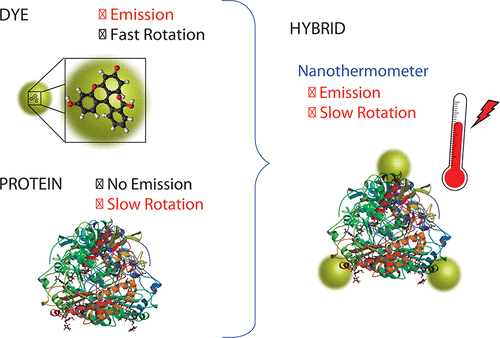当前位置:
X-MOL 学术
›
ACS Photonics
›
论文详情
Our official English website, www.x-mol.net, welcomes your
feedback! (Note: you will need to create a separate account there.)
Plug and Play Anisotropy-Based Nanothermometers
ACS Photonics ( IF 6.5 ) Pub Date : 2018-06-18 00:00:00 , DOI: 10.1021/acsphotonics.8b00292 Sebastian A. Thompson 1, 2 , Ignacio A. Martínez 3 , Patricia Haro-González 4 , Alejandro P. Adam 5 , Daniel Jaque 4, 6 , Jana B. Nieder 7 , Roberto de la Rica 1, 8
ACS Photonics ( IF 6.5 ) Pub Date : 2018-06-18 00:00:00 , DOI: 10.1021/acsphotonics.8b00292 Sebastian A. Thompson 1, 2 , Ignacio A. Martínez 3 , Patricia Haro-González 4 , Alejandro P. Adam 5 , Daniel Jaque 4, 6 , Jana B. Nieder 7 , Roberto de la Rica 1, 8
Affiliation

|
Temperature is a crucial parameter in biology, nanoelectronics, nanophotonics, and microfluidics. Optical methods excel for measuring temperature because they are noninvasive, spatially accurate, and can measure real time local changes in temperature. Among these, fluorescence anisotropy-based methods are particularly advantageous because they are less affected by changes in the probe concentration and irradiation conditions. However, at physiologically relevant temperature ranges in aqueous solution, fluorescence anisotropy contrast can only be achieved with rather large fluorescent proteins such as the green fluorescent protein (GFP), which can limit the range of applications through this method. Here, we propose a method to add thermosensitivity to any protein thereby transforming them into fluorescence anisotropy-based thermoprobes. It consists of covalently attaching a dye to the protein, which increases the rotational time of the dye-protein system compared to the free dye and confers thermosensitivity to the resulting bioconjugates. With this method we transformed bovine serum albumin, glucose oxidase and catalase into nanothermothers. This also allowed us to analyze the anisotropy signal changes occurring during the catalytic cycle of catalase, as well as their correlation with the reaction exothermicity. The potential of this method ensures applicability in extending temperature measurements to any protein-based experiments.
中文翻译:

基于即插即用各向异性的纳米温度计
温度是生物学,纳米电子学,纳米光子学和微流体学中的关键参数。光学方法擅长测量温度,因为它们是非侵入性的,空间精确的,并且可以测量实时的局部温度变化。其中,基于荧光各向异性的方法是特别有利的,因为它们受探针浓度和照射条件变化的影响较小。但是,在水溶液中生理上相关的温度范围内,荧光各向异性对比只能通过相当大的荧光蛋白(例如绿色荧光蛋白(GFP))来实现,这会限制通过此方法的应用范围。在这里,我们提出了一种对任何蛋白质添加热敏性的方法,从而将它们转化为基于荧光各向异性的热探针。它包括将染料共价连接到蛋白质上,与游离染料相比,增加了染料-蛋白质系统的旋转时间,并赋予了所得生物共轭物以热敏性。通过这种方法,我们将牛血清白蛋白,葡萄糖氧化酶和过氧化氢酶转化为纳米热疗剂。这也使我们能够分析过氧化氢酶催化循环过程中发生的各向异性信号变化,以及它们与反应放热的相关性。这种方法的潜力确保了将温度测量扩展到任何基于蛋白质的实验的适用性。葡萄糖氧化酶和过氧化氢酶转变成纳米热剂。这也使我们能够分析过氧化氢酶催化循环过程中发生的各向异性信号变化,以及它们与反应放热的相关性。这种方法的潜力确保了将温度测量扩展到任何基于蛋白质的实验的适用性。葡萄糖氧化酶和过氧化氢酶转变成纳米热剂。这也使我们能够分析过氧化氢酶催化循环过程中发生的各向异性信号变化,以及它们与反应放热的相关性。这种方法的潜力确保了将温度测量扩展到任何基于蛋白质的实验的适用性。
更新日期:2018-06-18
中文翻译:

基于即插即用各向异性的纳米温度计
温度是生物学,纳米电子学,纳米光子学和微流体学中的关键参数。光学方法擅长测量温度,因为它们是非侵入性的,空间精确的,并且可以测量实时的局部温度变化。其中,基于荧光各向异性的方法是特别有利的,因为它们受探针浓度和照射条件变化的影响较小。但是,在水溶液中生理上相关的温度范围内,荧光各向异性对比只能通过相当大的荧光蛋白(例如绿色荧光蛋白(GFP))来实现,这会限制通过此方法的应用范围。在这里,我们提出了一种对任何蛋白质添加热敏性的方法,从而将它们转化为基于荧光各向异性的热探针。它包括将染料共价连接到蛋白质上,与游离染料相比,增加了染料-蛋白质系统的旋转时间,并赋予了所得生物共轭物以热敏性。通过这种方法,我们将牛血清白蛋白,葡萄糖氧化酶和过氧化氢酶转化为纳米热疗剂。这也使我们能够分析过氧化氢酶催化循环过程中发生的各向异性信号变化,以及它们与反应放热的相关性。这种方法的潜力确保了将温度测量扩展到任何基于蛋白质的实验的适用性。葡萄糖氧化酶和过氧化氢酶转变成纳米热剂。这也使我们能够分析过氧化氢酶催化循环过程中发生的各向异性信号变化,以及它们与反应放热的相关性。这种方法的潜力确保了将温度测量扩展到任何基于蛋白质的实验的适用性。葡萄糖氧化酶和过氧化氢酶转变成纳米热剂。这也使我们能够分析过氧化氢酶催化循环过程中发生的各向异性信号变化,以及它们与反应放热的相关性。这种方法的潜力确保了将温度测量扩展到任何基于蛋白质的实验的适用性。









































 京公网安备 11010802027423号
京公网安备 11010802027423号